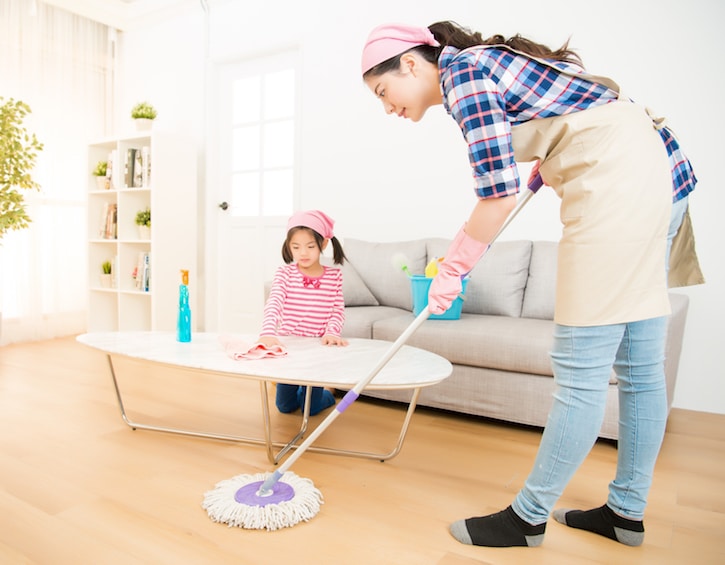
Building unity with your domestic helper
We’re back with part three of our helper-related posts about raising kids with a helper’s assistance. In part one, Melanie Leung-Shea from Helpwise shared advice on defining our helper’s role in our children’s lives, and in part two, we learned how to express our parenting preferences to our helper. Today, she offers us practical tips on how to build unity among our children and helper. Jot down some ideas and share this link with other mama friends who have helpers!
Parenting with a Helper: The Tricky Triangle
Trying to keep three people on the same page can be tricky. Just think of how hard it is when you’re working on projects at work or school, or even when simply trying to decide on a restaurant with multiple friends. So it’s no surprise that navigating a working and living relationship as uniquely complex as the one that exists between you, your helper, and your children may pose some parent-manager challenges.
Here are some suggestions for creating (and maintaining!) unity among the three integral members of your household.
Building Functional Trust
The Challenge:
I often hear employers say, “I don’t think I could trust my helper with feeding my newborn,” or “I’m not sure if I’ll ever be able to leave my helper alone with the kids.”
Tip: Make Trust Tangible
It’s easy to get stuck in a cycle of distrust if we don’t create a tangible plan that can help us build trust in our helper. To break the cycle, ask yourself: What practical steps need to happen in order for me to be more comfortable with that particular situation? Perhaps you do the feedings with her for three days straight, starting with her shadowing you and then you shadowing her. Maybe you could try leaving her alone with the kids for 30 minute increments, while providing her emergency instructions and asking her to send you an update or picture at the 15 minute mark to reassure you that things are going well.

Clarifying Responsibilities
The Challenge:
Since kids are constantly growing and changing, it’s helpful to frequently reexamine our preferences when it comes to the division of childcare responsibilities. For instance: Is it clear to every member of the household which adult you’d prefer to handle the kids’ bedtime routines? Do you prefer your helper to pack your child’s backpack so that it’s done correctly, or would you like your child to start taking on that responsibility themselves?
Tip: Make a Responsibility Chart
Take a piece of paper or a spreadsheet and make three columns for: “Parents”, “Helper”, and “Kids”. Think through your family’s day and assign each task (e.g. making breakfast, morning feeding for the baby, afternoon homework, tidying toys, etc.) into one of the three parties. Once you’ve completed it, make sure you share it with all members of your household. Keep in mind that you may want to revisit this chart from time to time and then re-clarify with all household members accordingly.
Behavior & Authority
The Challenge:
Sometimes we forget to communicate our expectations of how we want our kids and helpers to interact with each other, and how we’d like our helper to address any misbehaviour. If our helper hasn’t been taught how to encourage behavioural goals or administer consequences in a way that we would deem appropriate, then our children and helper will default to whatever actions (or inactions) may come naturally to them.
Tip: Make a Behavior Goal/Consequence List
It’s helpful to write down your behavioural goals for each child and also what you consider “unacceptable” behaviours and what the consequences for each of those behaviours will be. The consequences don’t have to be all the same; a preschool child forgetting to put away toys may only merit a reminder, whereas, you may want your helper to give you a call if your teen is caught lying about his or her whereabouts. Charting and communicating these goals and consequences will create consistency in the household, with all parties understanding what will happen if someone breaks one of the rules.

Introducing New Things
The Challenge:
When we spot something we’d like to do differently, we may tell either our helper, “I’d like Katie to start putting her own shoes away now”, or we tell our child, “I’d like you to start putting your own shoes away”, but sometimes we forget to tell them both and to make sure both of them have heard all of the information in the way that you intended.
Tip: Make Mini Announcements
When it comes to introducing new rules or ways of doing things, I find it helpful to speak to my child and my helper at the same time, making sure they both hear the same thing, straight from me. It creates a sense of accountability for the child and also takes the pressure off the helper when your child knows that you are the author of the new rules, not the helper.
For instance, I will say to my child in front of my helper, “The new rule is that I want you to put your own shoes away. If you don’t put them away, I want (our helper) to leave them out, so that I will know how you’re doing in practicing your responsibilities.” Then, turning to our helper in front of my daughter, I might say something like, “There’s no need for you to put the shoes away anymore. I know you might feel bad about leaving them out, but it won’t reflect poorly on you because this is no longer your responsibility. Please help us to help our daughter grow in this area.”
Tricky situations have a better chance of ending well if there is a plan in place ahead of time. If you realise your household could benefit from clarification in certain areas, jot down a few practical ideas that you think could help take some of the guesswork (or frustration) out of whatever common challenges your family is encountering. Sometimes a simple chart or clarifying conversation can provide you, your helper, and your children with a lot more security and confidence in your day-to-day interactions.
 View All
View All











 View All
View All





 View All
View All


 View All
View All











